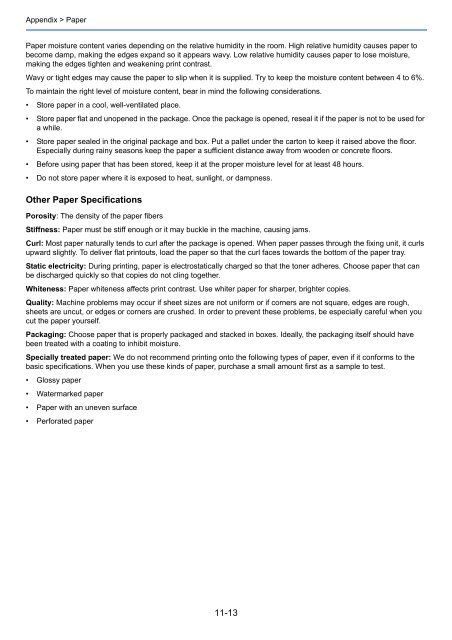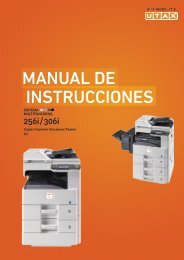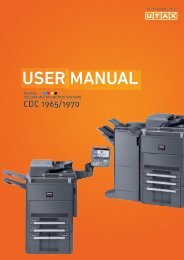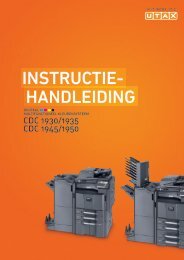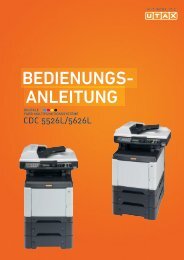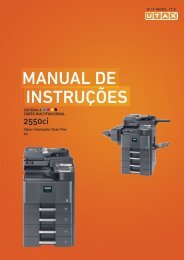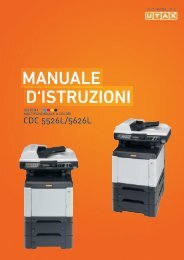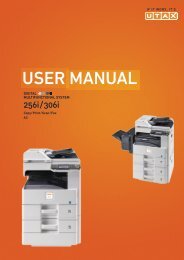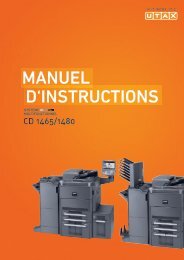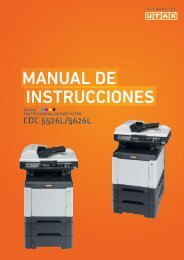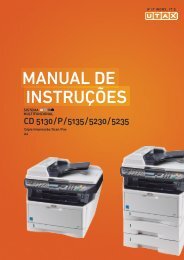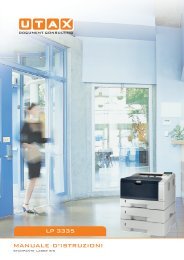- Page 1 and 2:
USER MANUALDIGITALMULTIFUNCTIONAL C
- Page 4 and 5:
Favorites .........................
- Page 6 and 7:
Internet ..........................
- Page 9 and 10:
Quick GuideTo make copiesBe sure to
- Page 11 and 12:
To send a FAXIt faxes.As well as se
- Page 13 and 14:
One Touch Key (page 6-16)Address Bo
- Page 15 and 16:
Print Job Status (page 8-3)Send Job
- Page 17 and 18:
Cassette/MP TraySettings (page 9-7)
- Page 19 and 20:
Document BoxSub Address Box (refer
- Page 21 and 22:
System (page 9-18) Network (page 9-
- Page 23 and 24:
1 PrefaceThis chapter explains the
- Page 25 and 26:
Preface > NoticeEnvironmentThe serv
- Page 27 and 28:
Preface > NoticeSafety Instructions
- Page 29 and 30:
Preface > Legal and Safety Informat
- Page 31 and 32:
Preface > Legal and Safety Informat
- Page 33 and 34:
Preface > About this Operation Guid
- Page 35 and 36:
Preface > About this Operation Guid
- Page 37 and 38:
2 Preparation beforeUseThis chapter
- Page 39 and 40:
Preparation before Use > Part Names
- Page 41 and 42:
Preparation before Use > Part Names
- Page 43 and 44:
Preparation before Use > Part Names
- Page 45 and 46:
Preparation before Use > Determinin
- Page 47 and 48:
Preparation before Use > Connecting
- Page 49 and 50:
Preparation before Use > Power On/O
- Page 51 and 52:
Preparation before Use > Installing
- Page 53 and 54:
Preparation before Use > Installing
- Page 55 and 56:
Preparation before Use > Installing
- Page 57 and 58:
Preparation before Use > Energy Sav
- Page 59 and 60:
Preparation before Use > Embedded W
- Page 61 and 62:
Preparation before Use > Embedded W
- Page 63 and 64:
3 Common OperationsThis chapter exp
- Page 65 and 66:
Common Operations > Loading PaperLo
- Page 67 and 68:
Common Operations > Loading Paper2T
- Page 69 and 70:
Common Operations > Loading Paper?2
- Page 71 and 72:
Common Operations > Loading PaperIM
- Page 73 and 74:
Common Operations > Loading Origina
- Page 75 and 76:
Common Operations > Checking the Eq
- Page 77 and 78:
Common Operations > Login/LogoutLog
- Page 79 and 80:
Common Operations > FavoritesFavori
- Page 81 and 82:
Common Operations > Favorites5Check
- Page 83 and 84:
Common Operations > FavoritesEditin
- Page 85 and 86:
Common Operations > FavoritesUsing
- Page 87 and 88:
Common Operations > ShortcutsShortc
- Page 89 and 90:
Common Operations > ShortcutsEditin
- Page 91 and 92:
Common Operations > Quick Setup Wiz
- Page 93 and 94:
Common Operations > Help ScreenHelp
- Page 95 and 96:
Common Operations > Using Various F
- Page 97 and 98:
Common Operations > Using Various F
- Page 99 and 100:
Common Operations > Using Various F
- Page 101 and 102:
Common Operations > Using Various F
- Page 103 and 104:
Common Operations > Using Various F
- Page 105 and 106:
Common Operations > Using Various F
- Page 107 and 108:
Common Operations > Using Various F
- Page 109 and 110:
Common Operations > Using Various F
- Page 111 and 112:
Common Operations > Using Various F
- Page 113 and 114:
Common Operations > Using Various F
- Page 115 and 116:
Common Operations > Using Various F
- Page 117 and 118:
Common Operations > Using Various F
- Page 119 and 120:
4 CopyingThis chapter explains the
- Page 121 and 122:
Copying > Basic Operation5 Entering
- Page 123 and 124:
Copying > Copying FunctionsZoomAdju
- Page 125 and 126:
Copying > Copying FunctionsDuplexCo
- Page 127 and 128:
Copying > Copying Functions4 Select
- Page 129 and 130:
Copying > Copying Functions1Display
- Page 131 and 132:
Copying > Copying FunctionsEcoPrint
- Page 133 and 134:
Copying > Copying FunctionsColor Ba
- Page 135:
5 PrintingThis chapter explains the
- Page 138 and 139:
Printing > Printing from Applicatio
- Page 140 and 141:
Printing > Printing Data Saved on t
- Page 142 and 143:
Printing > Printing Data Saved on t
- Page 144:
Printing > Printing Data Saved on t
- Page 147 and 148:
6 SendingThis chapter explains the
- Page 149 and 150:
Sending > Basic Operation1 Press th
- Page 151 and 152:
Sending > Preparation for Sending a
- Page 153 and 154:
Sending > Preparation for Sending a
- Page 155 and 156:
Sending > Preparation for Sending a
- Page 157 and 158:
Sending > Preparation for Sending a
- Page 159 and 160:
Sending > Preparation for Sending a
- Page 161 and 162:
Sending > Specifying DestinationDes
- Page 163 and 164:
Sending > Specifying DestinationEnt
- Page 165 and 166:
Sending > Specifying DestinationFor
- Page 167 and 168:
Sending > Specifying DestinationChe
- Page 169 and 170:
Sending > Registering Destinations
- Page 171 and 172:
Sending > Registering Destinations
- Page 173 and 174:
Sending > Registering Destinations
- Page 175 and 176:
Sending > Registering Destinations
- Page 177 and 178:
Sending > Registering Destinations
- Page 179 and 180:
Sending > Adding a Destination on O
- Page 181 and 182:
Sending > Sending FunctionsSending
- Page 183 and 184:
Sending > Sending Functions[Metric]
- Page 185 and 186:
Sending > Sending FunctionsE-mail S
- Page 187 and 188:
Sending > WSD ScanWSD ScanWSD Scan
- Page 189 and 190:
Sending > WSD ScanProcedure from Yo
- Page 191 and 192:
Sending > Scanning using TWAINItemD
- Page 193 and 194:
7 Document BoxThis chapter explains
- Page 195 and 196:
Document Box > Printing Documents S
- Page 197 and 198:
Document Box > Saving Documents to
- Page 199 and 200:
Document Box > Removing USB MemoryR
- Page 201 and 202:
Document Box > Functions for Docume
- Page 203 and 204:
Document Box > Functions for Docume
- Page 205 and 206:
Document Box > Functions for Docume
- Page 207 and 208:
8 Status / Job CancelThis chapter e
- Page 209 and 210:
Status / Job Cancel > Checking Job
- Page 211 and 212:
Status / Job Cancel > Checking Job
- Page 213 and 214:
Status / Job Cancel > Checking Job
- Page 215 and 216:
Status / Job Cancel > Sending the L
- Page 217 and 218:
Status / Job Cancel > Sending the L
- Page 219 and 220:
Status / Job Cancel > Check of Devi
- Page 221 and 222:
9 Setup, Registration,and User Mana
- Page 223 and 224:
Setup, Registration, and User Manag
- Page 225 and 226:
Setup, Registration, and User Manag
- Page 227 and 228:
Setup, Registration, and User Manag
- Page 229 and 230:
Setup, Registration, and User Manag
- Page 231 and 232:
Setup, Registration, and User Manag
- Page 233 and 234:
Setup, Registration, and User Manag
- Page 235 and 236:
Setup, Registration, and User Manag
- Page 237 and 238:
Setup, Registration, and User Manag
- Page 239 and 240:
Setup, Registration, and User Manag
- Page 241 and 242:
Setup, Registration, and User Manag
- Page 243 and 244:
Setup, Registration, and User Manag
- Page 245 and 246:
Setup, Registration, and User Manag
- Page 247 and 248:
Setup, Registration, and User Manag
- Page 249 and 250:
Setup, Registration, and User Manag
- Page 251 and 252:
Setup, Registration, and User Manag
- Page 253 and 254:
Setup, Registration, and User Manag
- Page 255 and 256:
Setup, Registration, and User Manag
- Page 257 and 258:
Setup, Registration, and User Manag
- Page 259 and 260:
Setup, Registration, and User Manag
- Page 261 and 262:
Setup, Registration, and User Manag
- Page 263 and 264:
Setup, Registration, and User Manag
- Page 265 and 266:
Setup, Registration, and User Manag
- Page 267 and 268:
Setup, Registration, and User Manag
- Page 269 and 270:
Setup, Registration, and User Manag
- Page 271 and 272:
Setup, Registration, and User Manag
- Page 273 and 274:
Setup, Registration, and User Manag
- Page 275 and 276:
Setup, Registration, and User Manag
- Page 277 and 278:
Setup, Registration, and User Manag
- Page 279 and 280: Setup, Registration, and User Manag
- Page 281 and 282: Setup, Registration, and User Manag
- Page 283 and 284: Setup, Registration, and User Manag
- Page 285 and 286: Setup, Registration, and User Manag
- Page 287 and 288: Setup, Registration, and User Manag
- Page 289 and 290: Setup, Registration, and User Manag
- Page 291 and 292: Setup, Registration, and User Manag
- Page 293 and 294: 10 TroubleshootingThis chapter expl
- Page 295 and 296: Troubleshooting > Toner Container R
- Page 297 and 298: Troubleshooting > Waste Toner Box R
- Page 299 and 300: Troubleshooting > Cleaning2Wipe the
- Page 301 and 302: Troubleshooting > Solving Malfuncti
- Page 303 and 304: Troubleshooting > Solving Malfuncti
- Page 305 and 306: Troubleshooting > Responding to Err
- Page 307 and 308: Troubleshooting > Responding to Err
- Page 309 and 310: Troubleshooting > Responding to Err
- Page 311 and 312: Troubleshooting > Responding to Err
- Page 313 and 314: Troubleshooting > Responding to Err
- Page 315 and 316: Troubleshooting > Clearing Paper Ja
- Page 317 and 318: Troubleshooting > Clearing Paper Ja
- Page 319 and 320: 11 AppendixThis chapter explains th
- Page 321 and 322: Appendix > Optional EquipmentExpans
- Page 323 and 324: Appendix > Optional EquipmentOption
- Page 325 and 326: Appendix > Character Entry MethodCh
- Page 327 and 328: Appendix > Character Entry MethodEn
- Page 329: Appendix > PaperBasic Paper Specifi
- Page 333 and 334: Appendix > PaperLabelBe sure to fee
- Page 335 and 336: Appendix > PaperRecycled PaperRecyc
- Page 337 and 338: Appendix > SpecificationsItemDescri
- Page 339 and 340: Appendix > SpecificationsEnvironmen
- Page 341 and 342: Appendix > Glossarynetwork. DHCP (I
- Page 343 and 344: Appendix > GlossarySMTP (Simple Mai
- Page 345 and 346: IndexAAddress BookAdding a Contact
- Page 347 and 348: LLabel 11-15Language 9-5LAN Interfa
- Page 349 and 350: Toner Container 2-3Checking the Rem
- Page 352: TA Triumph-Adler GmbH, Ohechaussee


